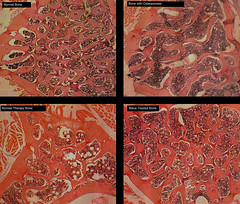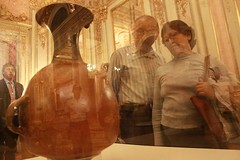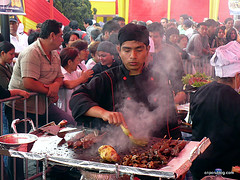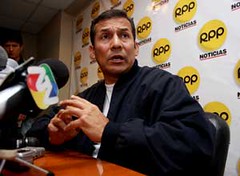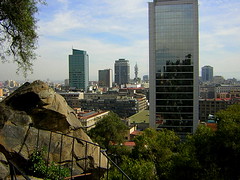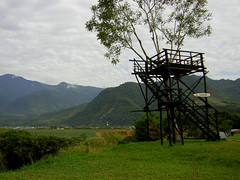The Cabanas and Collaguas are, or rather were, two distinct ethnic groups in the Colca area. Before Spanish conquest and intervention it was not permitted for the two groups to intermarry. The two groups distinguished themselves by creating different head deformations, one group had tall and thin skulls and one had fat and long skulls. They did this by tying two pieces of wood to the babies head until the affects were irreversible.
Category: "Travel and Places"
Yanque
Yanque is a small town that many tour operators in the area exploit for free entertainment for their clients, while the townsfolk exploit the flood of passing tourists by providing entertainment and photo opportunities in the hope of getting tips.
We passed through this town twice a few hours apart – and the people were still dancing. I hope the tips contribute to an energy-rich diet – but I doubt it.
Through the Patapampa
We left Arequipa in the early morning to head to Chivay, a town in the mountainous north of the department of Arequipa and one that is close to the Colca Canyon.
The journey was made interesting by the regular sightings of Vicuñas, Alpacas and Llamas.
Arequipa at Night
Arequipa takes on a very Parisian feel at night, with its grand arches and cathedral lit up in a very tasteful way (quite uncommon for South America).
These photos show what I mean.
Miradores de Arequipa
There are a few places with good views of the city – we visited two of them and took these photos.
Monasterio de Santa Catalina
The main attraction of Arequipa is the beautifully preserved Monastery of Santa Catalina.
This is a walled-off convent where 20 nuns still live, separate from the parts open to the public. It was built in the 15th century, founded by a rich window called Maria del Guzman…
Caminos del Inca
We were awoken at 6am the next day by the bus making a turn – a 180º turn that is. We were told by service provider Flaco (no-one did bother to learn his actual name) that a significant part of the Panamericana highway and all the road to Arequipa would be closed for a few hours. Peru´s international car race, known as Caminos del Inca, was taking place and we had to wait for the 20 cars to pass.
Mercado Central
The Mercado Central is a collection of streets in central Lima where you can buy just about anything. You’ll find little in the way of photos of these streets – as any cameras that take them will soon be stolen.
I managed to take these photos of the market without loosing my camera.
From there we walked further to the Monasterio de Santa Catalina, and brilliant blue and yellow convent. After a quick trip through China Town to buy oil for some homemade chifa and we were ready to go home.
Chile to Peru, the journey home
We had taken a bus to Santiago from Lima which made crossing the border simple. On the return however, there was no such bus, at least for a few days anyway.
We were able to take a bus from Iquique to Arica easily and had a good journey. The 4 hours on the bus were interesting as we spent them watching hundreds of tornadoes sweeping through the distant desert. I tried to get them on camera but they just wouldn’t turn out. The two photos attached to this entry are the best I could do, and I needed to turn up the contrast to get to see anything, but they still don’t give a feeling for how it really looked.
Chile: Cerros Pintados
There are over 400 geoglyphs drawn in the sand in the desert in the Reserva Nacional Pampa del Tamarugal depicting animals, humans and geometric patterns.
We arrive to see them as the sun was setting, when the sun wouldn’t bleach all the photos white.
Chile: La Tirana
La Tirana is a town of dusty streets and adobe houses with a church and a piece of history as its only attractions.
La Tirana is named after an Inca princess Huillac Ñusca. In 1535 Diego de Almagro, a Spanish conquistador, marched south from Cusco to conquer Chile. Only 500 Spaniards where willing to go with him to conquer these lands that they thought would be poor. So Diego de Almagro took with him ten thousand conquered Incas including the Inca princess and an Inca Prince. The party included, unknown to Almagro, a number of highly trained Wilkas (Inca Warriors) from the Inca Royal Army.
Chile: Nitrate Ghost Towns
Perhaps the highlight of our trip to Chile, other than just being in Chiloé, was visiting the abandoned ghost towns of the nitrate mining era. Just 30 minutes from Iquique are Humberstone and Santa Laura.




